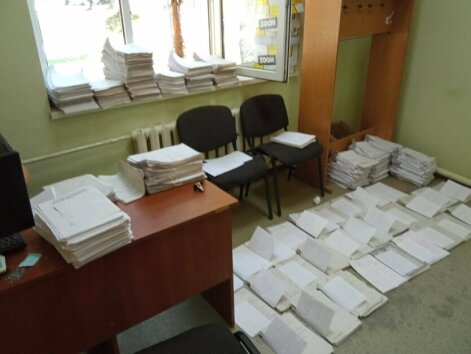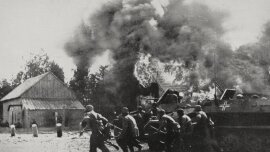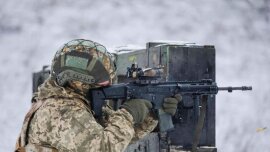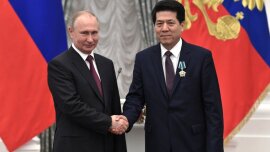The “technology idiots” came up with the idea that the military should record all the work of office computers on paper, and then make paper copies of all file archives.
YURIY RADCHENKO, PAVLO PAVLENKO

“Technology idiots” have come up with the idea that the military should record all the work of office computers on paper, and then make paper copies of all file archives (including passwords). As long as this insanity lasts, there is no question of any military automation. But there is hope …
1. Some terminology
“Technological idiocy” – a mass phenomenon of today, which consists in the use of fashionable “technical” words and (rarely) devices (such as “basebun” or an iPhone with Swarovski rhinestones) with almost complete misunderstanding (or ignorance) of the essence, laws and capabilities of IT- technologies.
A technological idiot in all other respects except understanding technology can be a great person. Therefore, the term itself is not medical: it should be considered in Greek, not in modern tradition, as “a person separated from a particular social process.”
2. Revenge of the bureaucracy
… It wasn’t us who first noticed that with the development of technology the relative amount of technological idiocy does not decrease, but increases. A striking example is our Armed Forces. It would seem that even local technical and military certificates are enough to understand what it means to react quickly to the actions of the enemy with the help of automated systems. But no. You would think that computer technology in the army exists to take over routine processes, right? To help the commander and the soldier to process the information, to encrypt it, and to transfer instantly to other colleague on armed fight against the opponent, through an electronic network … And, probably, you understand that automated systems, including military, work on the basis of computer techniques. All kinds of servers, routers and personal tablets-computers … That would all be right for business. But not for the military. Some military leaders, who can barely handle the “baseball phone”, perceived automation as a deadly danger. As a “Stranger” who clung to the ideal bureaucratic-paper system, the growth of which, like a cancerous tumor, year after year absorbs the efforts of all to the last servicemen, no matter how many states they hire …
“An ideal bureaucratic-paper system, growing like a cancerous tumor, year after year absorbing the efforts of all to the last servicemen, no matter how many states they hire.”
So, the “revenge” was not long in coming. As of 2017, such a bureaucratic counter-machine has been developed, which is guaranteed to level any automation process. And then the process of total implementation began. No automation, no. Cancer of the paper bureaucracy.
Technological idiocy: basics
How exactly? Very easy.
Technological idiots or saboteurs (even under Defense Minister Salamatin) obliged each user to keep a dozen titles of paper “magazines”, “forms” and “passports” that you must manually (!) fill in before, during and after working on (quote) servers (clusters), personal computers, laptops (laptops), PDAs, tablets, system units, input devices and (or ) output information (multifunction devices, printing devices (printers, plotters), copiers, scanners, display media (video projectors, video conferencing, video cameras, uninterruptible power supplies, active telecommunications equipment (hubs, switches, routers). 1]
For all these elements of the IT infrastructure, which, in theory, should get rid of paperwork and provide an advantage in the cycle of “observation – evaluation – decision-action” over the enemy – you not only have to draw up paper “forms”. You must keep a “Work Log” or a “Work Log” for each of these items. Even, as you can see, separately on the “personal computer” and separately on its “system unit” – which is pure, ideal insanity. Or the work of a cluster, which doesn’t look less stupid, because clusters can have hundreds and thousands of active computing elements that can be reconfigured independently depending on the task and load. Or even for each uninterruptible power supply and video projector …
What do you write with a pen, for example, in the “Logbook”? List of works and content (!) of the created document; what media (including the hard drive with its unique serial and registration number!) was used in this process (it would be interesting to see a record of the use of decent cluster drives: it is usually a set of RAID-arrays of hundreds of individual elements!); start time, end time; who did the work, how much time was used … It’s not easy: your record must be checked and approved by the “person in charge of the operation”… It is also necessary to record the results of anti-virus scanning. And in the “form” you must enter in parallel all the changes in software and hardware configuration (including, incidentally, with automated updates, which per day for the modern operating system comes to a few dozen).
You probably already understood that those who prepared these rules do not know (or, rather, do not want to know) or about computer “logs” (automated reports on the state of the system), which can be configured to log the computer. user with any detail; neither about the methods of remote administration, nor about the provision of automated data protection, nor about anything like that … But from one “journal of experience” you will not get a general picture of the “neo-Luddite revolt”.
3. Technological idiocy: building
So, in addition to the “Work Log” and the “form”, you make the following paper journals for EACH of your computer friends (and then, ideally, from the printer to the uninterruptible power supply according to the above-cited Order):
– logbook of copying information (from which medium, who, when, what information was written off);
– log of information erasure [2] (who, when, from which media which file of what volume and under whose control erased);
– antivirus update installation log [3];
– log of work on the ISD-Internet workstation [4] (ISD-Internet is a limited access to the Internet especially for the military, something at the time of the children’s surfing program NetNanny);
– log of incoming files [5] (registration number, from where, from which to which media, whose, how much file, who transferred, who received, who deleted): it is designed specifically for your e-mail, so that no file penetrates unnoticed!;
– log of source files [6] (same);
– hardware log [7], or the Journal of the accounting of work of the electronic computer (here again write time of switching on and switching off, but in addition – about the forced breaks in work and their reasons, time of carrying out maintenance, data on who carried it out, which detected faults and results of “control of technical condition by officials) [8] …
Don’t forget a few more “accounting cards” and lists (to be filled in “when the computer is connected to different networks”), “a list of allowed to work with a PC”, and you will laugh, but paper and approved by the head … password log.
To make it seem like, at the military unit level, we also need a “Military unit software log” (as if the people tasked with beating the enemy are the business of what their combat tablets work on), a logbook of ALL MEDIA (and a secret ”Army flash drive is made by wrapping an ordinary flash drive with a piece of paper with the seal of the part); and Antivirus Database Update Log. And separately for any automated systems – Work Log and, again, Password Log …
No, that’s not the end. If you process information with limited access – you must register the so-called “information security complex”, having prepared a separate “regime” room. And as soon as the room is ready – create 48 (this is not a figurative expression, but a real number) of various magazines, lists, instructions, statements, lists, acts and forms that are required to register a computer. Including the Violator Model and Threat Model documents, which you write for some reason, not a cybersecurity expert.
By the way, for such registration, your military administration will pay a lot of money (subject to periodic renewal of the permit). After all, who is the only one who “categorizes” office computer systems and the premises intended for their placement? Commercial structures!..
4. Technological idiocy: finalization
Not all “guidance documents” are cited in the references above, as some of them are restricted. But the important thing is also this: for each of the military networks (and for each level of access restriction within each military network) you must have … a separate device.
According to these requirements, the unit commander, for example, must have 7 to 8 separate computers / devices in the workplace to work in different control subsystems. Well, at least what you need: an automated control system for troops in general, one or two artillery control systems, a document management system, a personnel management system, several (wired + IP fixed + mobile) communication systems. But at the same time there is a requirement that they cannot be near and used at the same time. That is, no matter what level of access you have, you are not allowed to work with devices of different access levels at the same time. Just take turns so that you don’t think of copying something from one system / network to another, other than through a laser disk registered in a special magazine or a flash drive wrapped in paper with a stamp. In the best parts (where the commander tries to keep the focus of command of the troops and not violate the “guidance requirements”), try to get out of this by using terminals with mechanical switching (using a large packet switch) of information sources – but with varying success, because the general situation can be too dynamic and complex to evaluate it by the method of consistent work with almost a dozen different information systems …
But that’s not all.
What was mentioned above are, so to speak, “technical requirements”. However, there are also general requirements. After all, orders on electronic document management are valid only for the General Staff and the Ministry of Defense. And for military units, the norms specified in the Order of the National Security Service № 124 “Record keeping in the Armed Forces” apply. And they say that everything you have earned as documents – you are obliged to print, sew, register with the original signature and “wet” seal, and transfer to the archive.
Yes: electronic and paper documents are conducted in the Armed Forces in PARALLEL. And in this way it is necessary to draw up the ENTIRE document flow (telegrams, orders, warrants, applications, investigations), individual documents in which reach a volume of up to a thousand pages. And this is not considering the famous “Personal Affairs” …
And the last aspect. The average need of the unit for certified “information security systems” is about 100 (one hundred!) Pieces. This is understandable, because only 20,000 incoming and incoming documents pass through the unit’s headquarters a year without restricting access. Statutory requirements, I recall, include the provision of each order – adequate to perform “forces and means.” So how many categorized information processing systems do you think are available (apart from those that are in hardware and are configured to receive and send, in fact, mail)?
1 – 2, and both in headquarters. And all 20,000 incoming-outgoing documents, as a rule, are marked as created on these two complexes, constantly “connected” by the regular officers of the staff …
What does it mean? That the whole system of preparation of documentation, including reporting, at the tactical level is profane.
Everyone knows about it. But it suits everyone.
Why?
Because if you come up with and legitimize conditions that cannot be fulfilled in principle – you will all be guaranteed to be guilty. And everyone can be reprimanded, at least.
And there is no better means of manual control than to make everyone guaranteed to be guilty.
Thousands of people are working to provide a special complexity that no longer provides results, but only provides further expansion and deepening of reporting, with the involvement of more and more staff. That staff does not actually create any product or even a useful result, but tries to create endless reports, descriptions and regulations for the sole purpose of justifying their own existence. Realizing that the work will be evaluated for reporting, and not for something comprehensive, the staff does not make independent decisions, does not work, he controls the maximum. And the cancerous tumor grows.
5. Results
First: an incredible waste of time, an incredible loss of human resources. We know how many shovels, soldiers and time it takes to dig a trench under an armored personnel carrier – but no one risks even starting to calculate how many man-hours (and what insane amounts of money) are spent on this paper frenzy, 99.9 percent of which eaten by mice in the so-called “archives”, never used by anyone.
Second: the absolute reluctance of military units to implement automation, even if it is available. In fact, what kind of fool, instead of one, paper, bureaucratic system, which already consumes 80 percent of the time, will undertake, in fact, three: paper, automated, and paper-reporting on the progress of work and processes in automated systems?!
Third: almost complete misunderstanding of the tasks and possibilities of automation by the top military leadership. The famous phrase from the press conference of the former Commander-in-Chief about the leading combat automation system “Bell”, which successfully passed eight field exams, they say, there are tables, chairs and irons, no software – became a meme in the army.
Fourth: the inability to integrate into the overall automation system a lot of developments that have been done to improve the functionality of troops / forces, rather than for paper reporting. Known research and development work, which is done for decades without any tangible results; on the other hand, many fully effective models of weapons and information systems cannot be put into service.
Fifth: complete voluntarism in decision-making. The most striking example is the cessation of almost all military automation programs in the last year by only two “outstanding figures”: the head of the profile department of industry development (ironically!) And a recorded “fighter against corruption”), who simply “throws on the fan” in the blog … And this is no joke: half a dozen promising projects have been defeated, as many projects have already been funded; guaranteed lag in the means of automation from the enemy is no longer a year or two, but five or more.
6. Who do we work for?!
The last question is especially important. The fact of who you are objectively working for is determined by the direct results of your activities, not by the intentions you are guided by. In Ukraine, the situation of “useful fools” is not that common, but catastrophic. In recent years, it has become fashionable to cover up the blatantly destructive activities of the “fight against corruption” – but there are three interesting aspects to automation.
Firstly, in principle, it is impossible to find a powerful manufacturer that, during all the years of our independence, having survived Kuchma, Yushchenko, Yanukovych and their successors, has never entered into any agreements with the authorities. But this hardly means that the company’s management was to blame: the claims should be made to the customers: military and government officials.
Secondly, for two years of continuous audits and inspections in the field of military automation, no one has been arrested or even “reprimanded” for corruption. That is, real, as for the court, evidence of corruption is simply absent. There are mostly propaganda accusations that allow irresponsible balabolas to stay afloat of treacherous popularity and swim from NGO to NGO, from meeting to meeting, from buffet to buffet.
Thirdly, the actions of the “truth-tellers” themselves, as a result of which the entire industry was almost completely destroyed and the technological lag behind the enemy was ensured, fall not under corruption, but under the article “Treason.” But for some reason no one takes care of this…
7. What to do?
As a plumber said in an anecdote, “it’s not just taps that flow: the whole system needs to be changed” … In almost all ministries. The question, however, is how effective this new digitization infrastructure is without the same “forces and means.” After all, the biggest risk is the almost complete lack of tensions within higher-level administrations.
The controversy over the use of “directorates” to launch a process of permanent change to a rigidly established and formalized system of idiotic “rules” aimed at inflating the bureaucracy is as follows.
If you act according to the existing “normative documents” – you quickly return to the original situation, and create only another instruction not only in the old style, but also with the old approaches to the problem.
If you spit on the “regulatory documents” and look only at the technical and technological opportunities that are simply available on the market – everything you do will be logical, transparent, cheap and reliable, but completely illegal. And this illegality will be proved to you quickly, because you will break the monopoly of the bureaucracy on profit. And the truth, confirmed at the tactical level, is that only by means of system administration of obsolete corporate equipment, which is lying on OLX at a price of 300 UAH, you can achieve results that cost hundreds of millions of public funds in endless “scientific” and ” research and development” works.
Today, the program of digital reforms, and especially the program of digital reforms in the Armed Forces, is frozen in anticipation of the Administrative Decision. Even – Voluntary Decision. In anticipation of the emergence of a practitioner who would not be afraid of the negative admiration of formalists, making “unpopular” decisions. And he would have the courage to rudely (and, in a formal sense, illegally) break down the bureaucratic wall of paper workers, instruction generators, and Facebook grant-eaters.
We will not envy such a person if he appears, and especially in the Armed Forces. But without the appearance of such a person, I can only state that the most important IT reform, ie. IT reform in the Army, has reached a state of complete blockage.
Recent political changes, through which people with real (and, importantly, victorious, not losing!) Combat experience come to the top leadership, as well as with a real understanding of the role of modern technology, give some hope for the positive. These are names that are respected in the Armed Forces both because of their personal and professional qualities and because of their direct contribution to the development of the modern Army.
“Closed circles are broken by overexertion,” said one classic. “To destroy the enemy, it is not enough to suppress it with artillery fire; we will have to cross the battlefield on foot,” said another classic, a local.
It turns out that in the case of military digitalization and automation – it’s time to get up and go across the field.
Or – just forget that in this area we have some ambitions …
Authors: Candidate of Economic Sciences, Lieutenant Colonel Yuriy RADCHENKO, co-founder of the experimental unit of automated combat control systems; reserve lieutenant Pavlo PAVLENKO, ex-commander of the experimental unit of automated.
[1] Order of the Ministry of Internal Affairs №372 from 01.06.2021 “Guide to the technical support of information and telecommunication systems”
[2] Annex 5 to the Instruction on antivirus protection in ITS MOU and ZSU (Order MOU №391 from 07/26/2017)
[3] Annex 6 to the Instruction on anti-virus protection in ITS MOU and ZSU (Order MOU №391 from 26.07.2017)
[4] Annex 12 to the Procedure for the Use of the Internet in the MOU System (MOU Order №727 of 28.12.2016)
[5] Annex 10 to the Instruction on information exchange in the automated control system of the Armed Forces of Ukraine “Dnipro” (MOU Order №44 of January 29, 2015)
[6] Annex 4 to the Instruction on information exchange in the automated control system of the Armed Forces of Ukraine “Dnipro” (MOU Order №44 of January 29, 2015)
[7] Annex 69 to the Manual on Technical Support of Communications and ACS (Order of the National Security Service of the Armed Forces of Ukraine №22 of April 11, 2003)
[8] Annex 68 to the Manual on Technical Support of Communications and ACS (Order of the National Security Service of the Armed Forces of Ukraine №22 of April 11, 2003)
[9] https://analytics.hvylya.net/236982-reformatori-ukrajinskoji-armiji-znayomtes-yaroslav-gonchar-ekspert-z-finansovih-operaciy
Tags: Yuriy Radchenko / Pavlo Pavlenko / reform of the Ukrainian army / digitalization / Armed Forces / Armed Forces / automation / NATO / Army / army / reforms in the Armed Forces
























